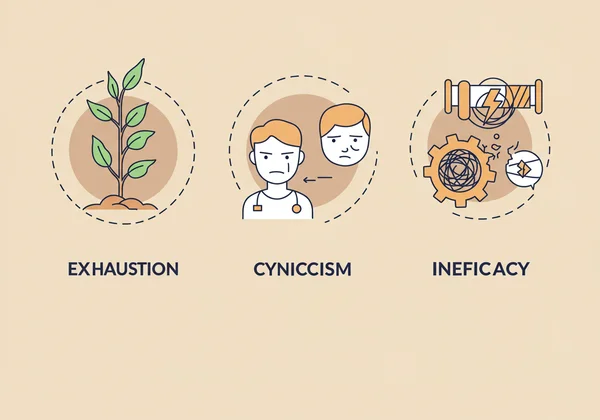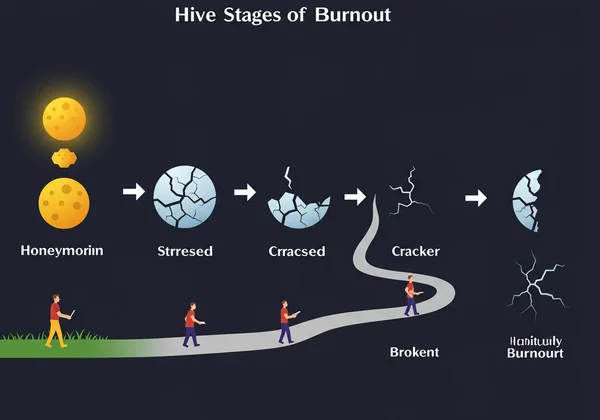Free Burnout Test & Guide: Occupational Burnout Symptoms, Stages & Recovery
Are you constantly drained, disengaged, and disillusioned with your work? That persistent feeling of exhaustion and detachment might be more than just a rough week. You could be experiencing occupational burnout, a state of physical, emotional, and mental exhaustion caused by prolonged workplace stress. This comprehensive guide will help you understand what burnout is, recognize its signs, and equip you with actionable strategies for recovery. The first step to feeling better is understanding where you are right now, and a simple Burnout Test can provide valuable insights.
What is Occupational Burnout? Defining the Condition
Think of occupational burnout as more than just work-related stress—it's a profound state of physical or emotional exhaustion that also involves a sense of reduced accomplishment and loss of personal identity. It's not just about feeling tired; it’s a deeper, more pervasive experience that can impact your health, relationships, and job performance. Recognizing it is the crucial first step toward recovery. If you're wondering if you're experiencing this condition, a reliable Burnout Test can offer initial clarity.

More Than Just Stress: Key Differences
While stress and burnout are related, they aren't the same. Stress is often characterized by over-engagement—a sense of urgency, hyperactivity, and heightened emotions. You might feel like you're drowning in responsibilities but still believe you can get things under control if you just try harder. In contrast, burnout is defined by disengagement. Emotions are blunted, and you may feel helpless and detached. Instead of hyperactivity, you experience emotional exhaustion and a lack of motivation.
The Three Core Dimensions: Exhaustion, Cynicism, and Inefficacy
Psychology researchers, particularly in the context of the Maslach Burnout Inventory (MBI), identify three core dimensions of burnout:
- Exhaustion: This is the central symptom. It’s a profound fatigue that isn’t relieved by rest. It manifests as a lack of energy to face the workday, feeling drained emotionally, and being unable to physically keep up.
- Cynicism (or Depersonalization): This involves developing a distant, negative, or indifferent attitude toward your job. You might feel detached from your work, your colleagues, and the people you serve. It's a psychological coping mechanism to distance yourself from overwhelming job demands.
- Inefficacy (or Reduced Personal Accomplishment): This is the feeling that you are no longer effective at your job. You may doubt your abilities, feel a lack of achievement, and struggle with productivity, which can create a vicious cycle of negativity.
If these dimensions sound familiar, it may be time to assess your risk and get a clearer picture of your situation.

Recognizing Burnout Symptoms: Take an Online Burnout Assessment
Burnout symptoms can be subtle at first but grow more severe over time. They manifest physically, emotionally, and behaviorally. Understanding these signs is key to early intervention. A burnout symptoms test can help you systematically review these areas.
Physical & Emotional Warning Signs
Your body often keeps score when it comes to chronic stress. Pay attention to these signals:
- Chronic fatigue and feeling tired most of the time
- Frequent headaches or muscle pain
- Changes in appetite or sleep habits
- Lowered immunity, leading to more frequent illnesses
- Feelings of helplessness, being trapped, and defeat
- A sense of detachment and feeling alone in the world
- Loss of motivation and an increasingly cynical or negative outlook
Behavioral Changes to Look Out For
Burnout also changes how you act at work and at home. You might notice:
- Withdrawing from responsibilities and isolating yourself from others
- Procrastinating and taking longer to get things done
- Using food, drugs, or alcohol to cope
- Skipping work or coming in late and leaving early
- Showing increased irritability or impatience with colleagues and loved ones
The 5 Stages of Burnout: From Honeymoon to Habitual
Burnout is a gradual process; it doesn't happen overnight. It typically progresses through five distinct stages. Knowing these stages can help you identify where you are and take action before it becomes critical.
Stage 1: The Honeymoon Phase
When you start a new job or take on a new project, you often experience high job satisfaction, commitment, and energy. However, during this phase, you may begin to establish unhealthy coping mechanisms (like pushing through exhaustion) that can lead to burnout later.
Stage 2: Onset of Stress
In this stage, you start to become aware that some days are more difficult than others. You might feel less optimistic and notice common symptoms of stress, such as anxiety, fatigue, or irritability. Your work-life balance may begin to suffer.
Stage 3: Chronic Stress
Here, stress becomes a more persistent part of your daily life. The symptoms from the previous stage intensify, and you may experience a marked change in your stress levels. You might feel pressured, out of control, and increasingly unmotivated. This is a critical point to seek help.
Stage 4: Burnout
At this stage, the symptoms become critical. Continuing as you are is no longer sustainable. You may feel overwhelmingly exhausted, cynical, and ineffective. Physical and emotional symptoms can become intense, and you might feel numb or empty.
Stage 5: Habitual Burnout
In the final stage, burnout becomes so embedded in your life that you experience it as your new normal. This can lead to significant long-term consequences, including depression or anxiety. The fatigue and sadness feel chronic and deeply ingrained.

Common Causes of Workplace Burnout
While individual factors play a role, burnout is largely a systemic issue stemming from the work environment. Understanding the causes can empower you and your organization to make meaningful changes.
Workload, Lack of Control, and Insufficient Resources
An unmanageable workload is a primary driver of burnout. When you constantly feel like you're falling behind, it's easy to become exhausted. This is compounded by a lack of control or autonomy over your work and not having the tools, information, or resources you need to do your job effectively.
Dysfunctional Workplace Dynamics & Lack of Support
A toxic work environment can be incredibly draining. This includes everything from workplace bullying and incivility to a lack of social support from colleagues and supervisors. Feeling isolated or that your contributions are unrecognized can severely deplete your emotional reserves and sense of purpose.
Strategies for Recovery & Prevention: Starting with a Burnout Test
The good news is that burnout is not a life sentence. With intentional strategies, you can recover and build resilience against future episodes. The journey starts with a single step, like taking a free burnout test to understand your personal situation.

The "Three R's" of Coping with Burnout
A helpful framework for recovery involves three key actions:
- Recognize: Watch for the warning signs of burnout and acknowledge them without judgment.
- Reverse: Actively seek support and manage stress by undoing the damage. This could involve taking time off, delegating tasks, or practicing relaxation techniques.
- Resilience: Build your resilience by focusing on your physical and emotional health through self-care, setting boundaries, and improving your stress management skills.
Building Resilience & Implementing Self-Care
Prioritizing your well-being is non-negotiable. This includes ensuring you get enough sleep, maintaining a healthy diet, and engaging in regular physical activity. Mindfulness, meditation, and hobbies that you enjoy can also help replenish your mental and emotional energy, creating a buffer against stress.
Setting Healthy Boundaries and Seeking Support
Learning to say "no" is a powerful tool against burnout. Set clear limits on your work hours and availability. Don't be afraid to ask for help from your manager, colleagues, friends, or family. Sometimes, talking to a mental health professional can provide you with the tools and perspective needed to navigate a challenging work environment. To begin this journey of self-discovery, why not start your assessment today?
Taking Control: Your Path to Understanding and Overcoming Burnout
Occupational burnout is a serious condition, but it is manageable and reversible. By understanding its definition, recognizing its symptoms, identifying its causes, and implementing effective recovery strategies, you can reclaim your well-being and find a healthier relationship with your work. The first step is always awareness. Gaining a clear, objective understanding of your current state is empowering.
Are you ready to take control? Take our free burnout test to get instant, confidential insights based on scientific principles. It’s the perfect first step on your path to recovery.
Disclaimer: This burnout test is an educational and self-assessment tool, not a substitute for professional medical advice, diagnosis, or treatment. If you are concerned about your health, please consult with a qualified healthcare provider.
Frequently Asked Questions About Occupational Burnout
How do you test for burnout?
A burnout test is a self-assessment questionnaire designed to measure your risk level across the core dimensions of burnout: exhaustion, cynicism, and inefficacy. Our platform offers a free, science-backed online burnout assessment that provides an instant summary of your results and an optional AI-driven report for deeper, personalized insights and an actionable plan.
Is it burnout or am I just lazy?
This is a common and painful question. Laziness is typically a choice or a lack of motivation for a specific task, often without accompanying distress. Burnout, on the other hand, is an involuntary state of emotional and physical exhaustion where you want to be productive but lack the capacity. It's not a character flaw; it's a response to chronic, unmanaged stress.
What can burnout be mistaken for?
Burnout shares symptoms with several other conditions, most notably depression and anxiety disorders. The key difference is that burnout is specifically work-related, while depression tends to be pervasive across all areas of life. However, chronic burnout can lead to depression. It's essential to consult a healthcare professional for an accurate diagnosis.
What does burnout fatigue feel like?
Burnout fatigue is different from regular tiredness. It's a bone-deep exhaustion that sleep doesn't seem to fix. You might wake up feeling just as tired as when you went to bed. It's a feeling of being completely depleted—mentally, emotionally, and physically—making it difficult to concentrate or even start the smallest tasks.